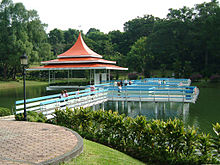MacRitchie reservoir
The MacRitchie Reservoir ( Chinese : 麦 里 芝 蓄水池, Pinyin : Maìlǐzhī Xùshuǐchí ) is Singapore's oldest reservoir . It was built in 1868 with an earth wall and was also known as the earth wall reservoir or Thomson reservoir .
history
Until the beginning of the 19th century, most of Singapore's main island was covered in primeval forest. Soon after the first British settlement was established in 1819, there was a demand for fresh water. But it would take decades before a drinking water supply was established .
Between 1820 and 1870 a substantial part of the jungle was cleared in order to develop Singapore into an important trading center. In 1886 only 10% of the original forest area was left. The first proposal for the construction of a drinking water reservoir was made in 1823, but it was not until 1857 that enough money appeared to be available for the construction of a reservoir, mainly thanks to financial support from the Chinese businessman Tan Kim Seng. The cost was estimated at $ 100,000. With the death of Tan Kim Seng in 1864, construction work came to a standstill and could probably only be completed in 1868. However, the installation of the water pumps and pipes did not finish until 1877, which resulted in a loss of public confidence in the government's ability.
In 1882 a fountain was erected in honor of Tan Kim Seng. In 1891 the capacity of the lake, now named Thomson Reservoir after its builder, British engineer John Turnbull Thomson , was expanded to 2.11 million cubic meters. Engineer James MacRitchie directed this expansion, which cost $ 32,000, and the reservoir was renamed in his honor in 1922.
However, the supply capacity of 18,000 cubic meters per day was not enough to meet demand. Other drinking water supplies were developed in 1912 and 1920, respectively. However, the government realized that Singapore was unable to meet its own fresh water needs. In 1927 a water treaty was signed with the Sultan of Johor. Singapore received its first shipment of water from Johor in 1932.
The development of the MacRitchie Reservoir was able to halt the death of the forest around the area. The forest was placed under protection as a water catchment area.
During World War II , the Japanese army that had occupied Singapore built a Shinto shrine , Syonan Jinja, in the middle of the MacRitchie area. During the reconquest of Singapore, the sanctuary was destroyed, either by British soldiers or by the Japanese themselves. The National Monument Protection Agency placed the site under protection in 2002.
Current condition
More than one square kilometer of primeval forest is still preserved in the Central Catchment Nature Reserve , especially around the MacRitchie reservoir. Rubber trees grow here, and the remains of the plantations from the 19th century can still be seen on the edges around the reservoir.
There are paths on boardwalks past the edge of the picturesque lake and hiking trails through the forest. They each have a length of 3 to 11 km. Signs along the paths allow a self-guided tour along the edges of the MacRitchie forest.
literature
- G. Uma Devi (2002): Singapore's 100 historical places. ISBN 978-981-4068-23-9 .
Individual evidence
- ↑ Sherlock Sam and the Cloaked Classmate in MacRitchie , accessed July 1, 2019
- ↑ Travel Know-How Travel Guide Singapore , accessed on July 1, 2019

